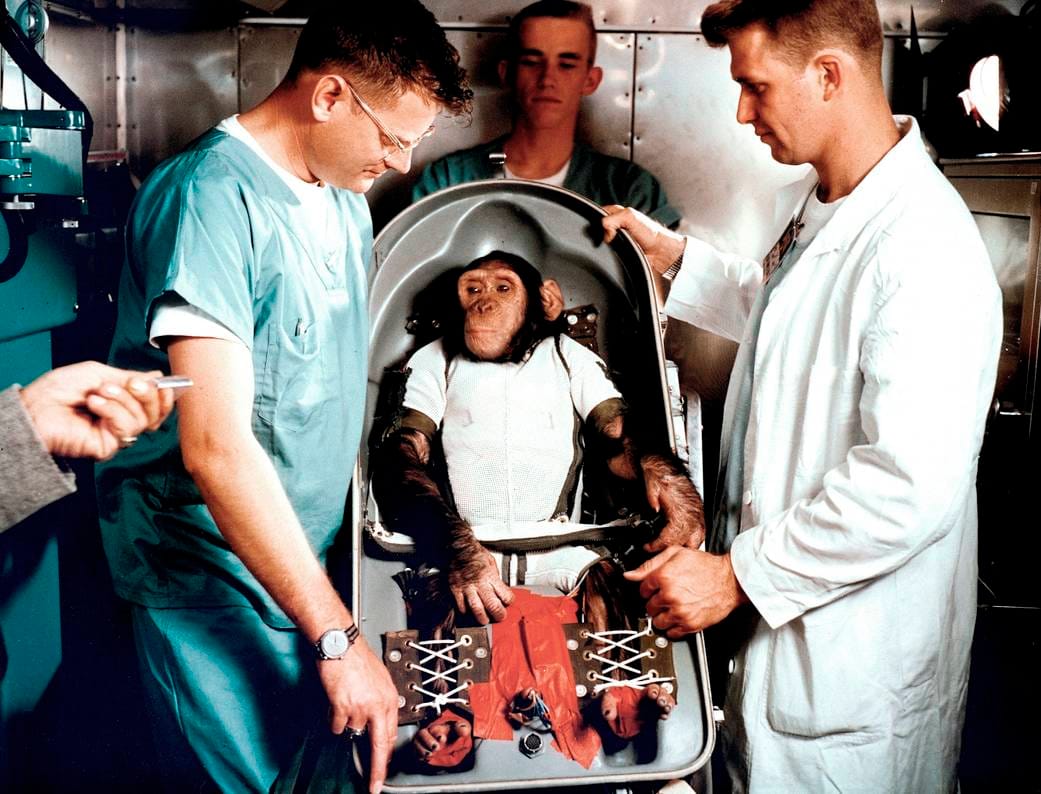From the jungles of Cameroon to the uncharted depths of space, Ham the chimpanzee’s extraordinary journey captivated the world. As the first hominin to orbit Earth, his pioneering mission in 1961 forever altered the course of human spaceflight. But behind the celebratory headlines lies a complex narrative interwoven with scientific triumph, ethical considerations, and the enduring legacy of animal astronauts.
A Chimp Destined for the Stars
Born in July 1957, Ham began his life in the forests of French Cameroon, only to be captured at the age of two and sold into a life he could never have imagined. Transported to the Rare Bird Farm in Miami, Florida, Ham, alongside 39 other chimpanzees, was eventually purchased by the U.S. Air Force, their destinies forever intertwined with the burgeoning space race.
Selected for Project Mercury, the ambitious U.S. program determined to launch a human into space, Ham’s intelligence and docile nature made him a prime candidate for rigorous astronaut training. Under the watchful eye of neuroscientist Joseph V. Brady at the Holloman Air Force Base Aero-Medical Field Laboratory, Ham embarked on a demanding regimen of timed tasks. Responding to light and sound cues, he learned to pull levers within five seconds, a seemingly simple act with potentially life-or-death consequences. Failure, as dictated by the protocols of the time, meant a mild electric shock—a controversial method that would later ignite fierce debate about animal welfare.
Launching into History
On January 31, 1961, strapped into the cramped Mercury capsule of the Mercury-Redstone 2 rocket, Ham’s destiny was realized. Blasting off from Cape Canaveral, he was propelled 157 miles above Earth at a breathtaking speed of 5,800 mph, his 16-minute and 39-second suborbital flight forever etching his name in the annals of space exploration. During those tense minutes, Ham didn’t just survive; he thrived. He executed his tasks with remarkable precision, proving that a living being could function cognitively amidst the disorienting forces of spaceflight and validating the life support systems designed to keep astronauts alive.
Ham’s remarkable performance paved the way for Alan Shepard’s historic mission just three months later, solidifying the chimpanzee’s place as a critical precursor to human spaceflight. But while Shepard returned to parades and global acclaim, Ham’s post-flight experience followed a different trajectory, one that continues to prompt reflection on the ethical dimensions of animal research.
Life After Space: A Complex Reality
Retired by NASA in 1963, Ham was transferred to the National Zoo in Washington, D.C., where he spent 17 years as a living testament to the possibilities of space exploration. However, his confinement, a stark contrast to his forested origins, sparked public discourse about the long-term impact of captivity on an animal that had once touched the stars.
Eventually, Ham was relocated to the North Carolina Zoo, where he lived out his days in a more naturalistic environment, a small comfort in a life forever altered by his extraordinary journey. On January 19, 1983, at the age of 25, Ham died, leaving behind a legacy as complex and multifaceted as the mission that defined him.
Ham’s Enduring Legacy: A Catalyst for Change
Ham’s story transcends the realm of scientific achievement. He is a powerful reminder of the ethical responsibilities we bear as we push the boundaries of knowledge. His training methods, considered standard practice at the time, ignited a firestorm of controversy, prompting a long-overdue examination of animal welfare in research settings.
Though he never chose his path, Ham’s journey forever altered the trajectory of human spaceflight and ignited vital conversations about the ethical treatment of animals in the pursuit of scientific progress. His story serves as a poignant reminder that every giant leap for humankind must be accompanied by compassion and a deep respect for all life on Earth.
What Happened to Ham the Chimpanzee?
After his groundbreaking flight, Ham the chimp became an instant celebrity. He spent 17 years at the National Zoo in Washington, D.C., captivating visitors with the story of the “astrochimp” who paved the way for human spaceflight. Recognizing the need for a more species-appropriate environment, the zoo later transferred Ham to the North Carolina Zoo, where he lived among other chimpanzees until his death in 1983 at the age of 26.
While Ham’s longevity speaks to advancements in animal care, his story continues to fuel debate about the long-term effects of spaceflight and captivity on animals. Did his unique experiences leave lasting psychological impacts? This question, among others, underscores the ethical complexities inherent in using animals for scientific advancement.
What Did Ham the Chimp Prove?
Ham’s mission wasn’t just about sending a chimpanzee into space; it was a crucial test of our ability to send humans safely beyond Earth’s atmosphere. His flight proved that a complex life form could survive the rigors of space travel, enduring intense G-forces, vibrations, and the physiological stresses of launch and re-entry.
More importantly, Ham demonstrated that a living being could perform tasks accurately and effectively in the weightless environment of space. His success validated life support systems, confirmed the feasibility of extravehicular activities, and provided invaluable data on the psychological effects of spaceflight on living organisms.
While Ham’s mission was a resounding success for the space program, it also exposed the ethical dilemmas inherent in using animals for scientific progress. His story serves as a stark reminder of the responsibility we bear to ensure the humane treatment of all creatures, even as we reach for the stars.
How Long Did Ham the Chimp Live?
Ham lived to be 26 years old, a testament to the care he received in the latter part of his life at both the National Zoo and the North Carolina Zoo. Despite the potential for long-term health complications arising from his spaceflight and the stress of training, Ham lived a relatively long life for a captive chimpanzee.
His story highlights not only the incredible advancements made in human spaceflight but also the evolving understanding of animal welfare and the ethical considerations surrounding the use of animals in research. Ham’s legacy continues to shape how we approach scientific exploration and the treatment of all creatures, reminding us that compassion and progress must go hand in hand.
Can you believe that Gussie Busch had four husbands?
- Unveiling Bernhard Caesar Einstein’s Scientific Achievements: A Legacy in Engineering - July 15, 2025
- Uncover who is Jerry McSorley: CEO, Family Man, Business Success Story - July 15, 2025
- Discover Bernhard Caesar Einstein’s Scientific Contributions: Unveiling a Legacy Beyond Einstein - July 15, 2025















